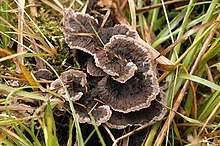Thelephora terrestris
Thelephora terrestris is an inedible species of fungus in the Basidiomycota phylum.[1] It is commonly known by the name Common Fiber Vase because of its circular and overlapping cap.[2] As well, it has also been called the Earthfan fungus.[3]
| Thelephora terrestris | |
|---|---|
 | |
| Scientific classification | |
| Kingdom: | |
| Division: | |
| Class: | |
| Order: | |
| Family: | |
| Genus: | |
| Species: | T. terrestris |
| Binomial name | |
| Thelephora terrestris Ehrh. (1787) | |
History and taxonomy
This fungus was first described by Jakob Friedrich Ehrhart.[4]
Habitat and ecology
Throughout North America[2] and Europe[4] Thelephora terrestris can be found in soil. It is commonly found in sandy soils under pine trees, on roots[2] and twigs.[5]
As this ectomycorrhizal fungi forms a symbiotic relationship with the pinus species, it forms mycorrihizae.[6] It is commonly found in pine forests[7] as well as plant nursery soils world wide.[8] This fungi is known to get water and nutrients from far away[9] and being capable of growing in both low; fertile and high fertile soils.[3]
After a disturbance such as a forest fire, will re-establish quickly and is considered stress tolerant,[10] as well it is a dominant mycorrhizal fungus.[8]
Outside of the pinus species, it is also capable of forming mycorrizha with other trees such as alder, birch, oak, beech, and poplar.[3]
Thelephora terrestris virus 1 (TtV1), which is a mycovirus, can infect this fungi.[3]
Growth and morphology
Thelephora terrestris is present year round, though is mostly seen July to December.[2] As the fruiting body forms, it starts off lighter in colour then turns to a darker shade of brown as it ages.[6] A stalk may not be present, if there is one, it is usually very short.[2] Sometimes the fungi is grown in large colonies.[5] The shape is described as a fan and can grow up to 6cm wide.[5] It has been described to have a moldy earth like smell.[2]
The hyphae of mycorrhizal forms walls that becomes thicker as it ages, while in earlier stages may be spiney.[11] When mating, the hyphae forms clamp connections[6] The spores are purple-brown colour,[2] ellipsoid or angular shape.[5]
Physiology
The full life cycle can be reproduced and studied in a laboratory, both ectomycorrhizal form and mushroom form.[12]
Due to the mycotoxins that the fungi produces, it protects pinus trees from root pathogen Phytophthora cinnamomi.[8]
References
- Radulović, Niko; Quang, Dang Ngoc; Hashimoto, Toshihiro; Nukada, Makiko; Tanaka, Masami; Asakawa, Yoshinori (2005). "Pregnane-Type Steroids from the Inedible Mushroom Thelephora terrestris". Chemical & Pharmaceutical Bulletin. 53 (3): 309–312. doi:10.1248/cpb.53.309.
- National Audubon Society field guide to North American mushrooms. Knopf. 1981. p. 413. ISBN 0-394-51992-2.
- Petrzik, Karel; Sarkisova, Tatiana; Starý, Josef; Koloniuk, Igor; Hrabáková, Lenka; Kubešová, Olga (February 2016). "Molecular characterization of a new monopartite dsRNA mycovirus from mycorrhizal Thelephora terrestris (Ehrh.) and its detection in soil oribatid mites (Acari: Oribatida)". Virology. 489: 12–19. doi:10.1016/j.virol.2015.11.009. PMID 26700067.
- Burt, Edward Angus (May 1914). "The Thelephoraceae of North America. I". Annals of the Missouri Botanical Garden. 1 (2): 185–227. doi:10.2307/2989992. JSTOR 2989992.
- Ellis, Martin B.; Ellis, J. Pamela (1990). Fungi without gills (hymenomycetes and gasteromycetes) : an identification handbook (1st ed.). Britain: Chapman and Hall. ISBN 0-412-36970-2.
- López-Gutiérrez, Araceli; Perez-Moreno, Jesus; Hernández-Santiago, Faustino; Uscanga-Mortera, Ebandro; García-Esteva, Antonio; Cetina-Alcalá, Victor Manuel; Cardoso-Villanueva, María del Rosario; Xoconostle-Cázares, Beatriz (19 June 2018). "Nutrient mobilization, growth and field survival of Pinus pringlei inoculated with three ectomycorrhizal mushrooms". Botanical Sciences. 96 (2): 286. doi:10.17129/botsci.1239.
- Moeller, Holly V.; Peay, Kabir G. (27 July 2016). "Competition-function tradeoffs in ectomycorrhizal fungi". PeerJ. 4: e2270. doi:10.7717/peerj.2270. PMC 4974999. PMID 27547573.
- Smith, Sally E; Read, David J (2002). "Mycorrhizal Symbiosis". Academic Press (2): 470–489. doi:10.1016/B978-012652840-4/50018-8.
- Hilszczańska, Dorota; Małecka, Monika; Sierota, Zbigniew (January 2008). "Changes in nitrogen level and mycorrhizal structure of Scots pine seedlings inoculated with Thelephora terrestris" (PDF). Annals of Forest Science. 65 (4): 409. doi:10.1051/forest:2008020.
- Veselá, Petra; Vašutová, Martina; Edwards-Jonášová, Magda; Cudlín, Pavel (29 January 2019). "Soil Fungal Community in Norway Spruce Forests under Bark Beetle Attack". Forests. 10 (2): 109. doi:10.3390/f10020109.
- Agerer, R.; Weiss, M. (29 August 2018). "Studies on Ectomycorrhizae. XX. Mycorrhizae Formed by on Norway Spruce". Mycologia. 81 (3): 444–453. doi:10.1080/00275514.1989.12025766.
- Birraux, D.; Fries, N. (November 1981). "Germination of basidiospores". Canadian Journal of Botany. 59 (11): 2062–2064. doi:10.1139/b81-267.